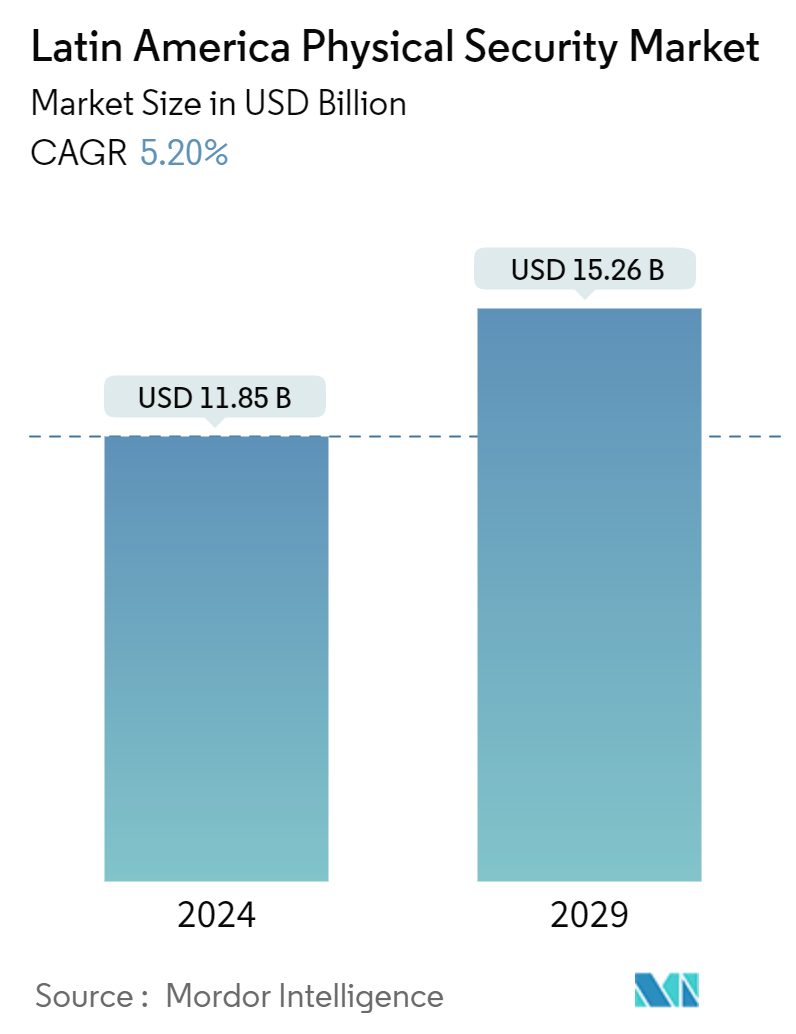Market Size of Latin America Physical Security Industry

| Study Period | 2019 - 2029 |
| Base Year For Estimation | 2023 |
| Market Size (2024) | USD 11.85 Billion |
| Market Size (2029) | USD 15.26 Billion |
| CAGR (2024 - 2029) | 5.20 % |
| Market Concentration | Low |
Major Players
*Disclaimer: Major Players sorted in no particular order |
Latin America Physical Security Market Analysis
The Latin America Physical Security Market size is estimated at USD 11.85 billion in 2024, and is expected to reach USD 15.26 billion by 2029, growing at a CAGR of 5.20% during the forecast period (2024-2029).
- Physical security provides a secure framework for businesses to identify hazards and potential risks before they occur, intentionally or unintentionally. It safeguards personnel, assets, and data from unauthorized access. This productivity can be achieved by implementing various security measures, such as combination locks, alarm systems, security cameras, and lighting. The need for physical security solutions is expected to increase due to labor shortages.
- The physical security market in Latin America has undergone significant advancements, transitioning from traditional security measures like armed personnel and physical searches to more advanced ICT-based solutions. These include video surveillance, biometrics, RFID, and other cutting-edge security services. It is crucial to prioritize implementing strong security measures to protect government organizations, public places, businesses, and critical infrastructures from potential terrorist threats, sabotage, or unauthorized entry.
- The security system can be monitored from a distance or on-site and consists of cameras, DVRs, and NVRs. Video surveillance management systems monitor entry points and prevent unauthorized entry. Video surveillance systems typically employ various technologies, such as CCTV technology. The development of advanced video surveillance technologies, such as high-resolution cameras, intelligent analytics, and remote monitoring capabilities, is increasing the need for more advanced video surveillance solutions.
- In June 2023, RGB Spectrum announced the installation of a video wall processor for the command-and-control center at the Chilean port. The port, which is Chile's second busiest port, was facing increased demand for cruise and freight services and necessitated a significant improvement in real-time tracking of operations, such as ship loading, unloading, and drug and explosives detection, to improve personnel's ability to identify and respond to potential concerns quickly and efficiently.
- Latin America has a significant demand for physical security solutions. The industrial sector in the area is experiencing convergence, which suggests that the market is increasingly adopting these solutions to address criminal activities. As a result, spending in this sector is expected to rise in the upcoming years. Countries like Brazil, Argentina, México, Chile, and others are likely to lead the way in the physical security market in Latin America.
- Hybrid-cloud adoption is on the rise in the physical security space. For instance, according to various sources, the onset of the pandemic in Mexico in November 2022 led to a surge in demand for cloud-based services. As a result, the cloud became an increasingly important component of any organization's strategic plan, even more so than before the outbreak.
- The market for physical security has been steadily expanding, although there was a slight decline during the pandemic. However, the post-pandemic scenario further stimulated the demand for voice control within homes, increasing awareness and acceptance of additional intelligent home devices and services. As a result, there is likely to be a shift in consumer spending toward technology-based services for residential consumption. Physical security systems allowed compliance with hygiene regulations and mask requirements.
- The installation costs of physical security systems are a significant restraining factor that may prevent some organizations from utilizing them. Physical security systems typically incorporate innovative technologies such as AI (artificial intelligence), machine learning (ML), Internet of Things (IoT) devices, and sensors, which can be costly to develop and implement. In addition, physical security systems require periodic maintenance, and the maintenance costs are borne by the end users of that equipment over its lifetime, thus increasing the burden on end users.
Latin America Physical Security Industry Segmentation
Physical security refers to preventing unauthorized intruders from accessing controlled facilities. Physical security technologies have developed significantly recently, offering advanced protection at competitive prices. Physical security devices utilize cloud technology and AI for even more sophisticated real-time data processing. Various automated physical security components can perform multiple functions in a physical security system.
The Latin American physical security market is segmented by system type (video surveillance system [IP surveillance, analog surveillance, and hybrid surveillance], physical access control system (PACS), biometric system, perimeter security, and intrusion detection), service type (Access Control-as-a-Service (ACaaS) and Video Surveillance-as-a-Service (VSaaS)), type of deployment (on-premises and cloud), organization size (SMEs and large enterprises), end-user industry (government services, banking and financial services, IT and telecommunications, transportation and logistics, retail, healthcare, residential, and other end-user industries), and country (Brazil, Mexico, Argentina, and the Rest of Latin America). The report offers the market sizes and forecasts for all the above segments in terms of value (USD).
| By System Type | |||||
| |||||
| Physical Access Control System (PACS) | |||||
| Biometric System | |||||
| Perimeter Security | |||||
| Intrusion Detection |
| By Service Type | |
| Access Control as a Service (ACaaS) | |
| Video Surveillance as a Service (VSaaS) |
| By Type of Deployment | |
| On-Premises | |
| Cloud |
| By Organization Size | |
| SMEs | |
| Large Enterprises |
| By End-user Industry | |
| Government Services | |
| Banking and Financial Services | |
| IT and Telecommunications | |
| Transportation and Logistics | |
| Retail | |
| Healthcare | |
| Residential | |
| Other End-user Industries |
| By Country*** | |
| Brazil | |
| Mexico | |
| Argentina | |
| Colombia | |
| Chile |
Latin America Physical Security Market Size Summary
The Latin American physical security market is experiencing a transformative shift, moving from traditional security measures to advanced ICT-based solutions. This evolution is driven by the increasing need to protect personnel, assets, and data from unauthorized access and potential threats. The market is witnessing a growing demand for sophisticated security systems, including video surveillance, biometrics, and RFID technologies, as businesses and government organizations prioritize the protection of critical infrastructures and public spaces. The rise in criminal activities and the need for enhanced security measures are prompting investments in advanced video surveillance technologies, such as high-resolution cameras and intelligent analytics, to ensure real-time monitoring and response capabilities.
The market landscape is characterized by a fragmented structure with numerous players adopting strategies like research and development, partnerships, and mergers to maintain competitiveness. Key companies such as Bosch Security Systems, Dahua Technology, and Johnson Controls are at the forefront, offering innovative solutions that integrate AI, IoT, and cloud technologies. The adoption of hybrid-cloud solutions is gaining traction, particularly in response to the increased demand for cloud-based services post-pandemic. Despite the high installation and maintenance costs of these systems, the growing awareness of security needs and the benefits of advanced technologies are driving the market's expansion across countries like Brazil, Argentina, and Mexico.
Latin America Physical Security Market Size - Table of Contents
-
1. MARKET INSIGHTS
-
1.1 Market Overview
-
1.2 Industry Attractiveness - Porter's Five Forces Analysis
-
1.2.1 Bargaining Power of Suppliers
-
1.2.2 Bargaining Power of Consumers
-
1.2.3 Threat of New Entrants
-
1.2.4 Threat of Substitutes
-
1.2.5 Intensity of Competitive Rivalry
-
-
1.3 Impact of COVID-19 Aftereffects and Other Macroeconomic Factors on the Market
-
-
2. MARKET SEGMENTATION
-
2.1 By System Type
-
2.1.1 Video Surveillance System
-
2.1.1.1 IP Surveillance
-
2.1.1.2 Analog Surveillance
-
2.1.1.3 Hybrid Surveillance
-
-
2.1.2 Physical Access Control System (PACS)
-
2.1.3 Biometric System
-
2.1.4 Perimeter Security
-
2.1.5 Intrusion Detection
-
-
2.2 By Service Type
-
2.2.1 Access Control as a Service (ACaaS)
-
2.2.2 Video Surveillance as a Service (VSaaS)
-
-
2.3 By Type of Deployment
-
2.3.1 On-Premises
-
2.3.2 Cloud
-
-
2.4 By Organization Size
-
2.4.1 SMEs
-
2.4.2 Large Enterprises
-
-
2.5 By End-user Industry
-
2.5.1 Government Services
-
2.5.2 Banking and Financial Services
-
2.5.3 IT and Telecommunications
-
2.5.4 Transportation and Logistics
-
2.5.5 Retail
-
2.5.6 Healthcare
-
2.5.7 Residential
-
2.5.8 Other End-user Industries
-
-
2.6 By Country***
-
2.6.1 Brazil
-
2.6.2 Mexico
-
2.6.3 Argentina
-
2.6.4 Colombia
-
2.6.5 Chile
-
-
Latin America Physical Security Market Size FAQs
How big is the Latin America Physical Security Market?
The Latin America Physical Security Market size is expected to reach USD 11.85 billion in 2024 and grow at a CAGR of 5.20% to reach USD 15.26 billion by 2029.
What is the current Latin America Physical Security Market size?
In 2024, the Latin America Physical Security Market size is expected to reach USD 11.85 billion.

